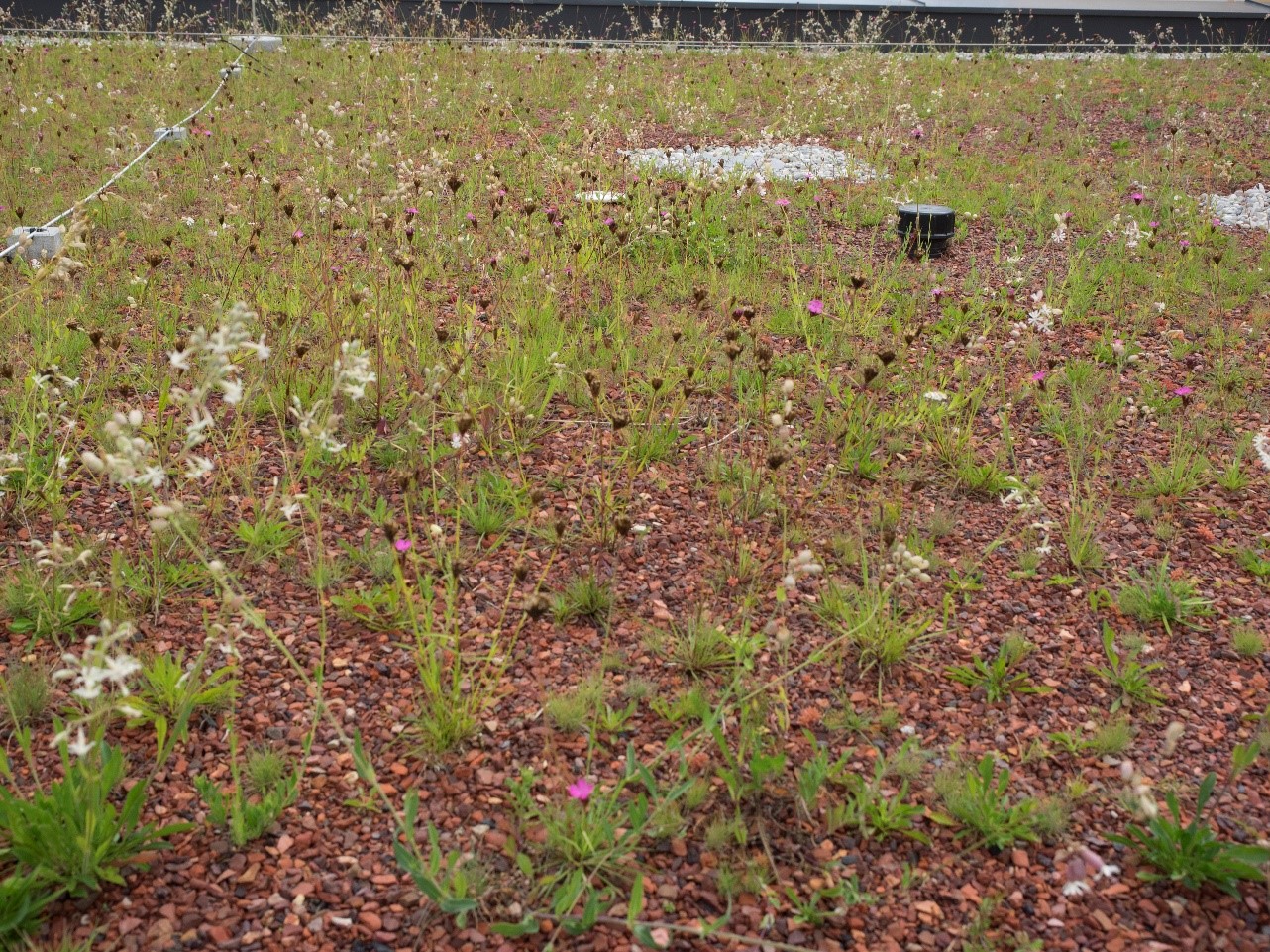The maintenance requirements are relatively low, as the vegetation is largely self-sustaining if the roof is constructed correctly and the right species are selected. The build-up layer thickness is between 10 and 20 cm. In addition, the microclimate is positively influenced and leads to a reduction in the ambient temperature through evaporation.
Structural requirements:
The practicality and cost-effectiveness of a green roof depend largely on the type of roof construction, with the roof pitch playing a major role. Flat roofs require a different system structure than pitched roofs. Roof pitch: To avoid waterlogging, the roof pitch should be at least 2%. If the slope is less than 2%, a sufficiently dimensioned drainage or drainage layer must be installed to avoid the formation of puddles. Green roofs are usually built on substructures made of concrete and wood; a lightweight construction such as trapezoidal sheets is also possible, with special consideration of the load-bearing capacity.
Load acceptance:
The majority of the weight of a green roof is made up of the substrate layer and the drainage layer. As a rule of thumb, a water-saturated substrate weight of approx. 13 to 15 kg per cm height and m² can be assumed. Calculated per square meter, the weight of the extensive greenery when saturated with water is a maximum of 300 kg/m². Films of very high quality are already available for sealing. Defects in the tightness of the roof are often due to a lack of accuracy on the part of the company carrying out the work.
All types of green roofs, whether single-layer or multi-layer, have the following layer structure:
vegetation layer, filter layer and drainage layer. The layers described consist of different materials. The vegetation layer serves as a root space for plants and stores water and nutrients. It is a mixture of mineral and, to a small extent, organic components that is intended to be permeable to water and structurally stable in order to prevent compaction of the base layer and maintain its functionality for decades. The filter layer, usually consisting of a rot-proof filter fleece, is permeable to water, but keeps the fine particles from penetrating the drainage underneath. The drainage layer has the task of draining excess water with a time delay so that waterlogging does not occur. However, drainage layers can also be used to store additional water, increase the root space or aerate the roots or protect the underlying waterproofing from damage. For reasons of weight, mainly light materials are used to build the drainage layer on the roof, such as drainage mats, plates and elements made of plastic or fillings made of brick chippings, expanded clay or lava. Appropriately shaped drainage elements can retain rainwater in depressions on the top.
Sowing: After installing the vegetation layer, the dry-resistant herb-grass seed mixture of regional origin is sown by hand at 5g/m² in accordance with the Gumpensteiner certificate of origin (G-Zert). Starting fertilization with organic long-term fertilizer (application amount equivalent to 40 kg pure N/ha) makes sense.
Vegetation: Low-growing plant community that is optimally adapted to the exposed location and can tolerate high temperatures with long dry periods, wind and frost. Sowing grasses, herbs and ground covers such as sedum makes sense for extensive green roofs.
Care: little care is required, no watering or fertilization is required. One inspection per year to remove unwanted growth such as trees is sufficient
Rainwater retention: The water absorption through the substrate, the plants and through evaporation is at a level of 20-50% in the spring and summer months, while in the winter months only very small amounts of rainwater can be retained. The reason for this is the natural saturation of the soil in the cool season and the lack of transpiring green matter. In general, the positive effect of water absorption and water storage capacity through green roofs and the associated reduction in runoff peaks during heavy rainfall should be emphasized.
Heat and cold protection : Extensive green roofs protect against extreme solar radiation on hot days as well as very low temperatures in winter. This increases the service life of the roof structure and also has a positive effect on the microclimate. The greenery cools through the natural properties of the plants, and the solar energy absorbed is used for growth. By constantly releasing moisture, plants create evaporative cooling. The denser the plant population, the better the cooling effect and the less the area heats up. Under the roof there is a reduction in temperature and thus an improvement in animal welfare in the stables.
Example of an extensive green roof:






